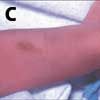Photoclinic: Sucking Blisters
Photoclinic: Sucking Blisters




These photos of 3 newborns taken at 1 or 2 days of age represent a broad picture of how sucking blisters may present. Photo A shows a dried blister on the right distal extensor forearm. Photo B shows a linear array of dried blisters along the distal extensor radial forearm. Photos C and D show dried brown epithelium on the medial third of the radial flexor surfaces bilaterally.
As would be expected, writes Robert P. Blereau, MD, of Morgan City, La, sucking blisters occur mainly on the forearms, wrists, hands, and fingers and rarely on the toes.1 The blisters, which range from 5 to 15 mm in diameter, are the result of sucking by the fetus in utero. The diagnosis is confirmed if the neonate continues to suck the same areas after birth.
The lesions usually resolve spontaneously, and no specific treatment is necessary. It is important to reassure the infant's parents of the benign nature of the lesions.
References:
REFERENCE:
1.
McMillian JA, DeAngelis CD, Feigin RD, et al.
Oski's Pediatrics: Principles and Practice.
3rd ed. Philadelphia: Lippincott Williams & Wilkins; 1999:380.